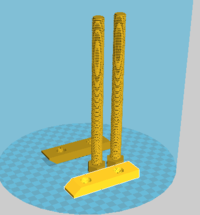| Line 59: | Line 59: | ||
== Benefited Internet Communities == | == Benefited Internet Communities == | ||
* Name and add links to at least 5 using single brackets around [url name] | * Name and add links to at least 5 using single brackets around [url name] | ||
Revision as of 04:12, 4 December 2019
OSTAT Ground Collector
Project developed by Andy Finch
Template:Statusboxtop Template:Status-design Template:Status-prototype You can help Appropedia by contributing to the next step in this OSAT's status. Template:Boxbottom
Abstract
- Paragraph description of the OSAT - why is it Appropriate? What need does it fulfil? Are there case studies you have found of a technology being used successfully?
- Picture of completed print using your printer

Bill of Materials
- Provide a full BOM -- Materials needed for fabrication of device and alternative materials if they are not available, prices/sources of non-printable parts
- Upload and link to all source files from open source CAD
- Upload and link to all STLs
Tools needed for fabrication of the OSAT
- MOST Delta RepRap or similar RepRap 3-D printer
Skills and Knowledge Necessary to Make the OSAT
- If you used special skill – link to relevant Wikipedia or Wikiversity articles/courses
Technical Specifications and Assembly Instructions
- Provide directions for print/assembly - be detailed enough in your “how to” to ensure that someone could construct the device from your description. Consider the elegance of IKEA like instructions.
- Include print time estimate
- Include assembly time estimate
- Including drawings or pictures of the device at stage of assembly at minimum. (http://www.appropedia.org/Special:Upload)
- Consider video if appropriate
| Example video summary of textbook |
|---|
Error in widget YouTube: Unable to load template 'wiki:YouTube' |
Common Problems and Solutions
- Include common mistakes/problems to avoid in building your OSAT and how to overcome them
Cost savings
Part Cost Total $19.62
- 30x Coat Hangers (or equivalent wire) $4.32
- 2x 5/8"-36" Dowel Rods (or equivalent stick) $8.58
- Broom Handle (or equivalent handle) $3.32
- 3D Print's Material Cost $3.40 (assuming $20/kg of PLA)
Prices for non-3D printed parts are based on the items purchased for the prototype. Recycled wire and wood could be substituted in place of store purchased items.
Commercial Equivalent
Savings
- Compared to the cheapest Walmart gather, the 3D printed ground gather brings the price down by a third.
- If recycled wood rods and wire were used in place of the purchased coat hangers and dowel rods, the price of the 3d printed ground gather could be decreased further.
Benefited Internet Communities
- Name and add links to at least 5 using single brackets around [url name]